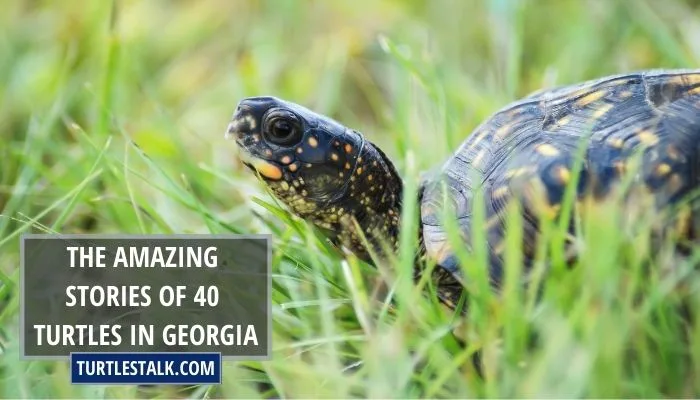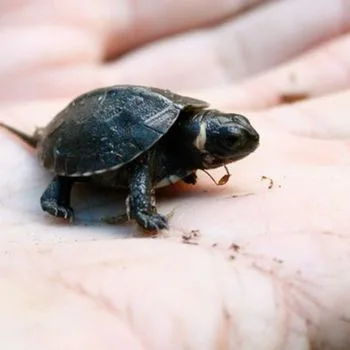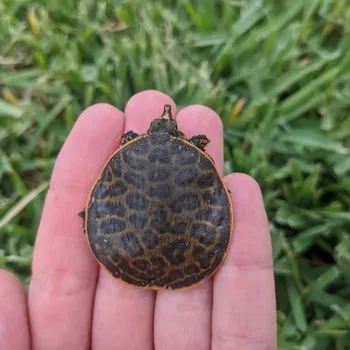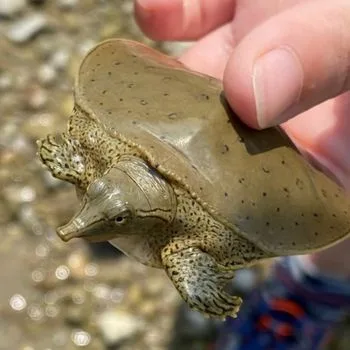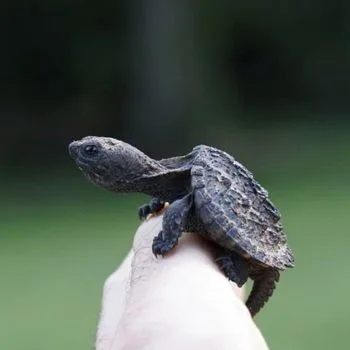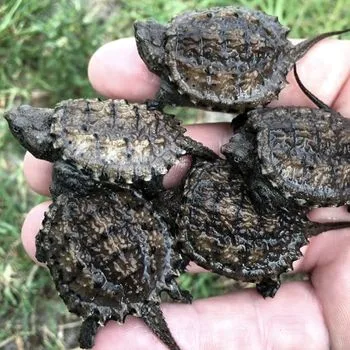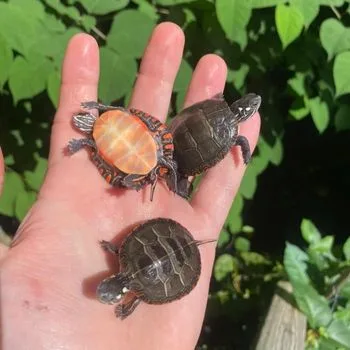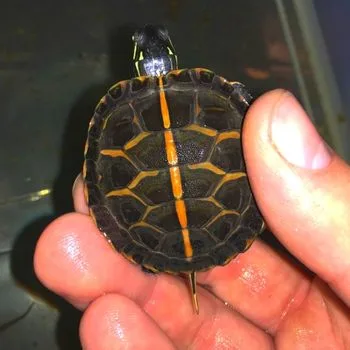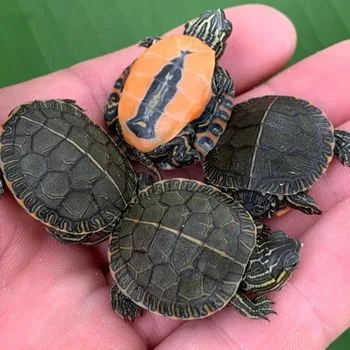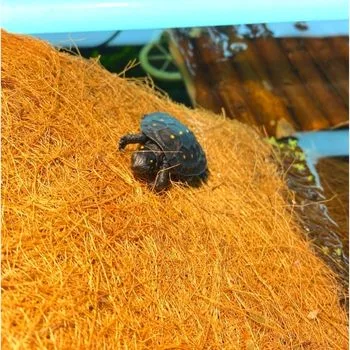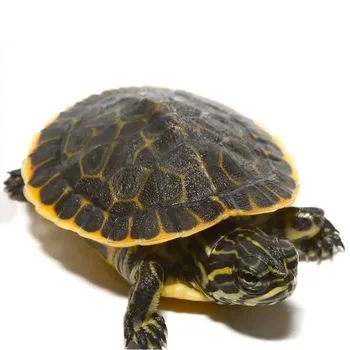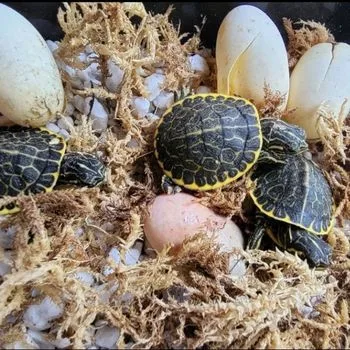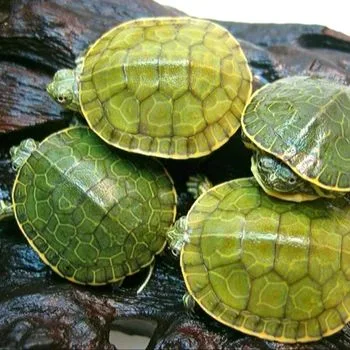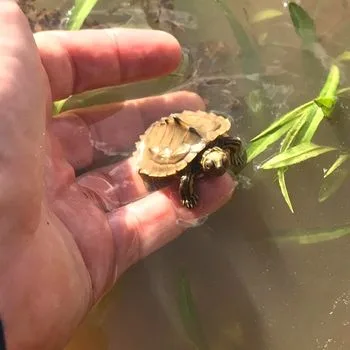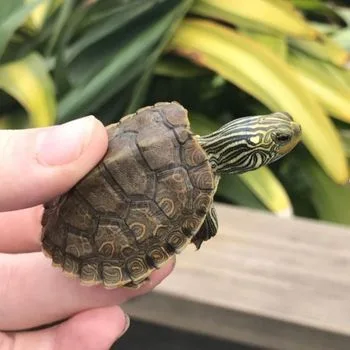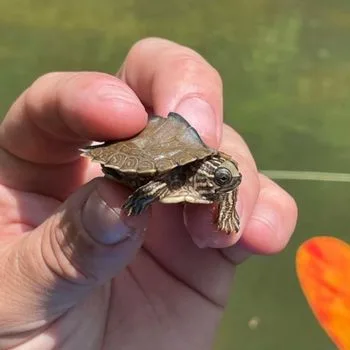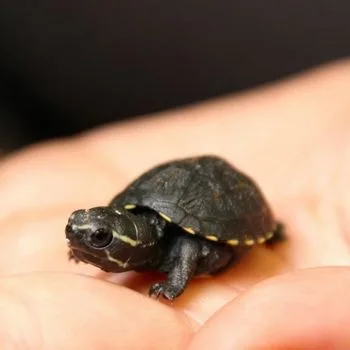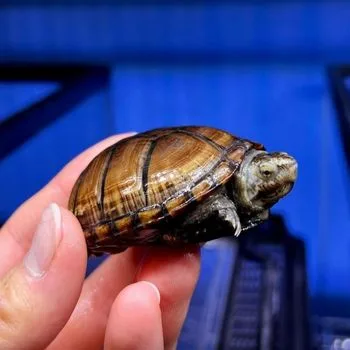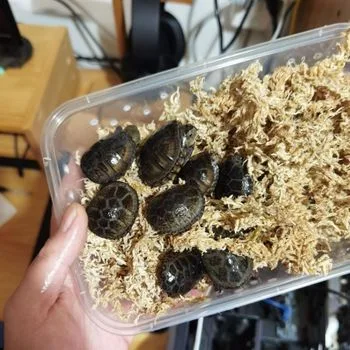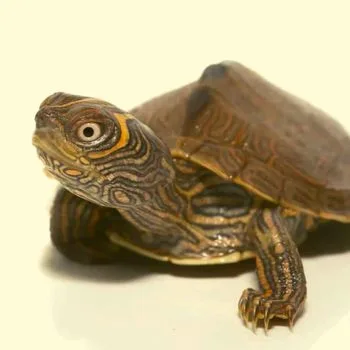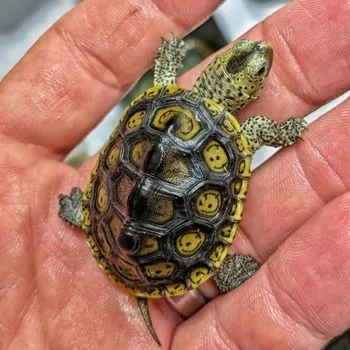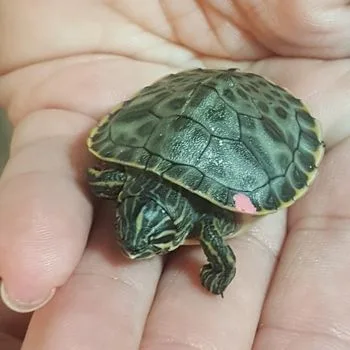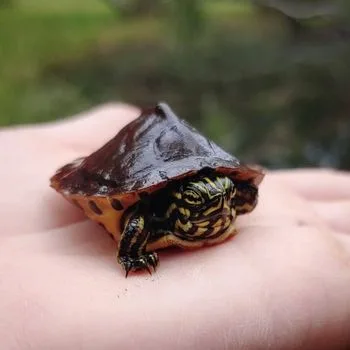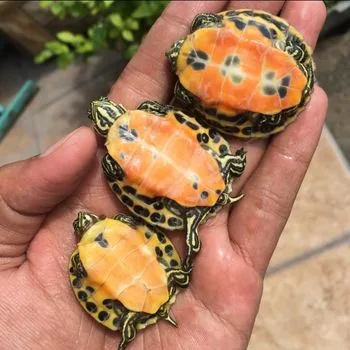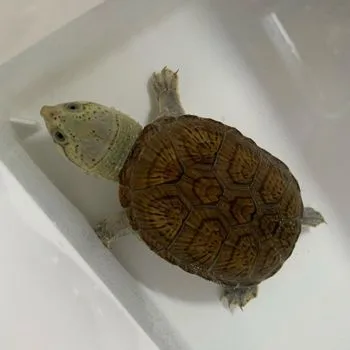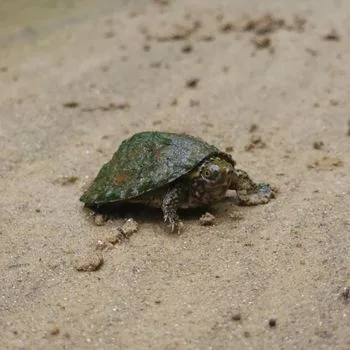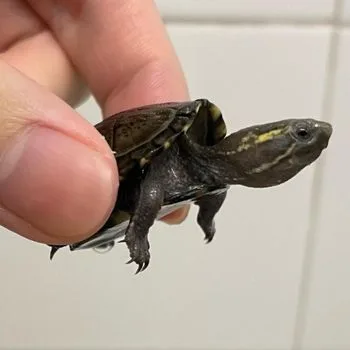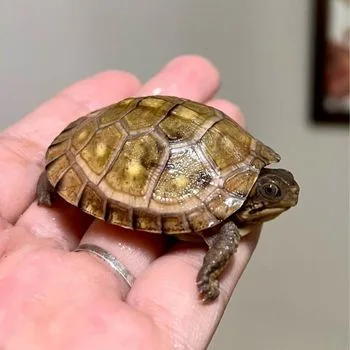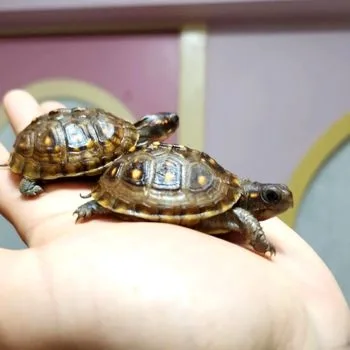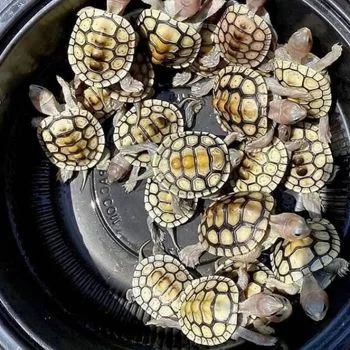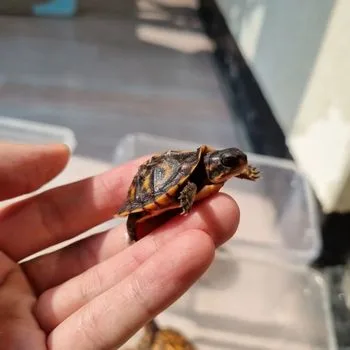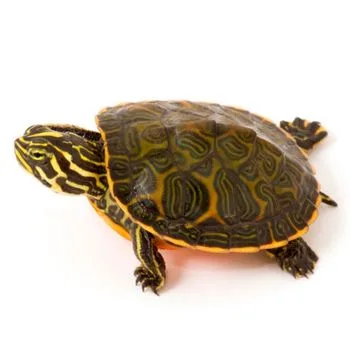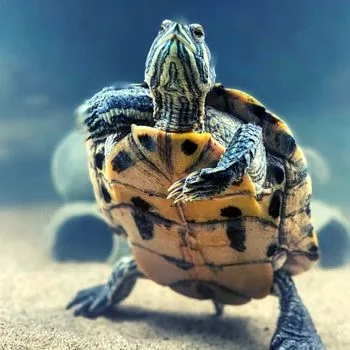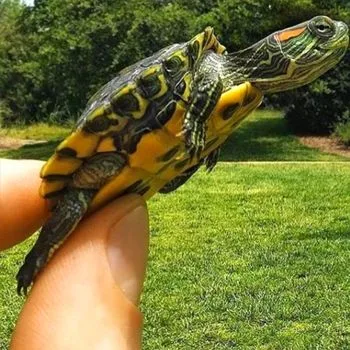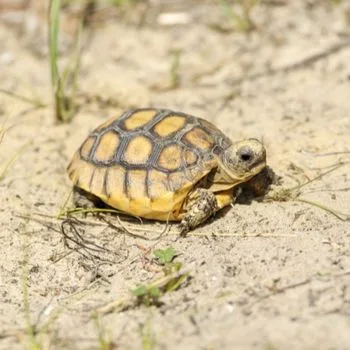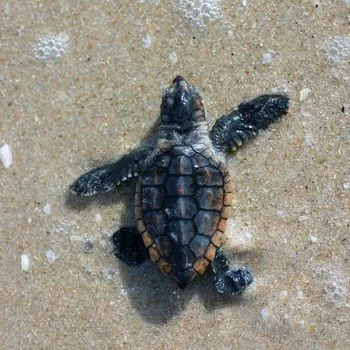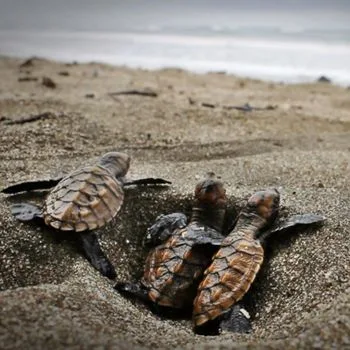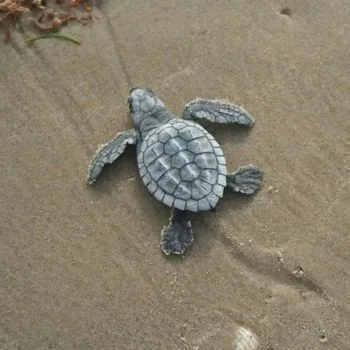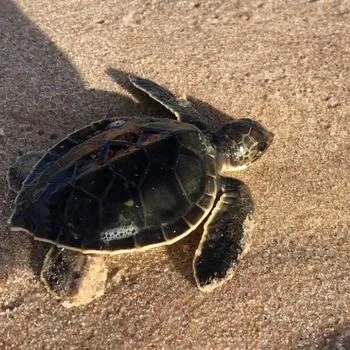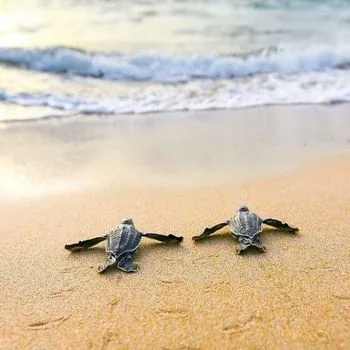The Amazing Stories of 40 Turtles in Georgia
The majestic and mysterious sea turtles of the world have captivated the human imagination for centuries. These creatures are a vital part of our global marine ecosystem, with seven species found across the globe – five of which can be spotted along Georgia’s coast!
From loggerheads to greens, leatherbacks to Kemp’s ridleys and hawksbills, these remarkable reptiles have made their homes in this region.
The loggerhead is particularly prominent here; it is the only species that nests regularly on Georgia’s barrier islands. Let us explore further into this wonderful turtle population that includes 40 different species.
| # | Name | Details | Image |
| 1 | Bog Turtle |
| 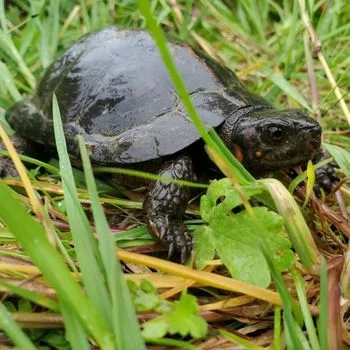 |
| 2 | Florida Softshell Turtle (Apalone Ferox) |
| 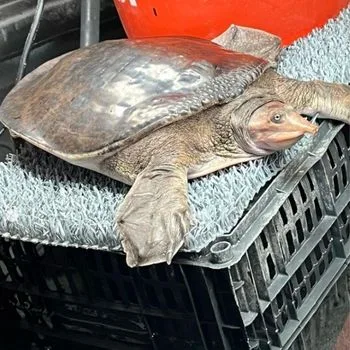 |
| 3 | Eastern Spiny Softshell Turtle (Apalone Spinifera) |
| 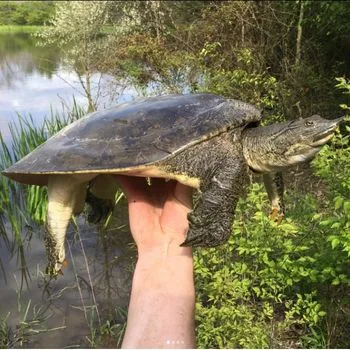 |
| 4 | Common Snapping Turtle (Chelydra serpentina) |
| 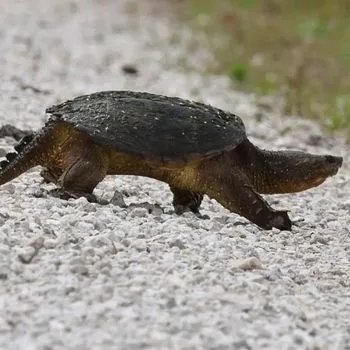 |
| 5 | Alligator Snapping Turtle (Macrochelys Temminckii) |
| 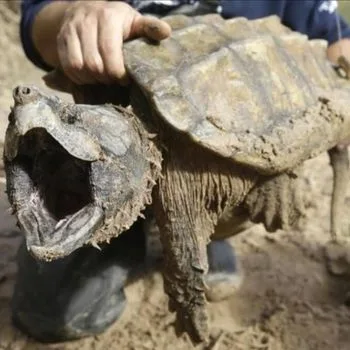 |
| 6 | Eastern Painted Turtle (Chrysemys Picta) |
| 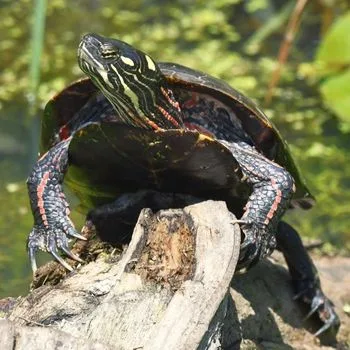 |
| 7 | Western Painted Turtle |
| 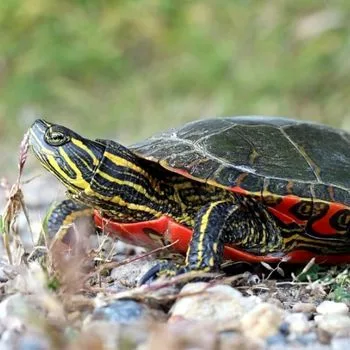 |
| 8 | Southern Painted Turtle (Chrysemys picta) |
| 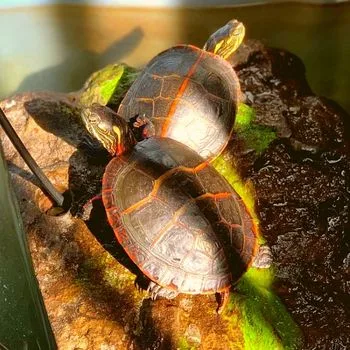 |
| 9 | Midland Painted Turtle (Chrysemys Picta Marginata) |
| 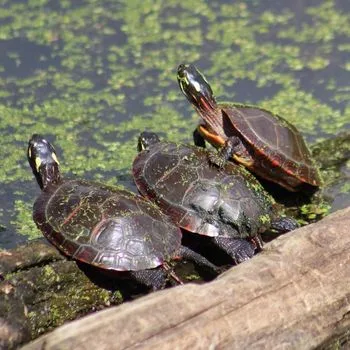 |
| 10 | Spotted Turtle (Clemmys Guttata) |
| 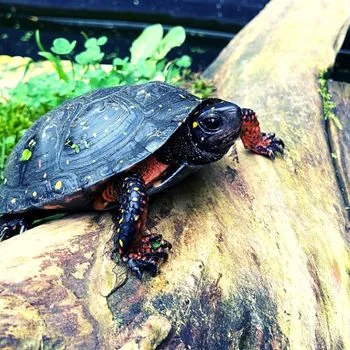 |
| 11 | Eastern Chicken Turtle (Deirochelys Reticularia) |
| 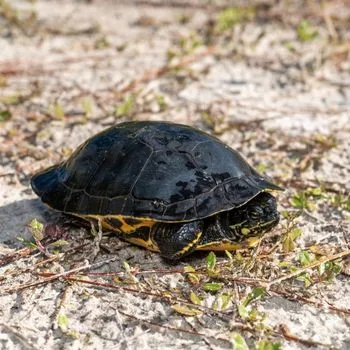 |
| 12 | Florida Chicken Turtle (Deirochelys Reticularia Chrysea) |
| 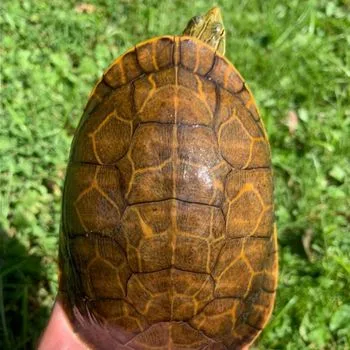 |
| 13 | Western Chicken Turtle (Deirochelys Reticularia Miaria) |
| 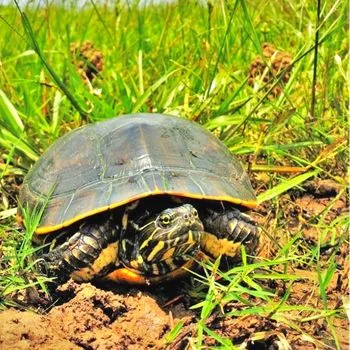 |
| 14 | Barbours Map Turtle (Graptemys Barbouri) |
| 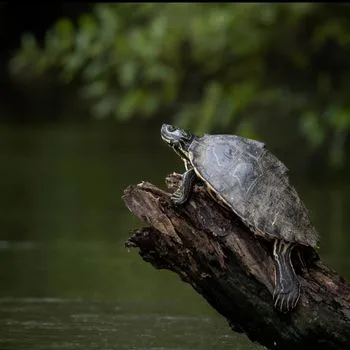 |
| 15 | Common Map Turtle (Graptemys Geographica) |
| 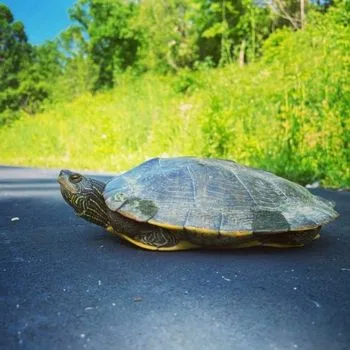 |
| 16 | Alabama Map Turtle (Graptemys Pulchra) |
| 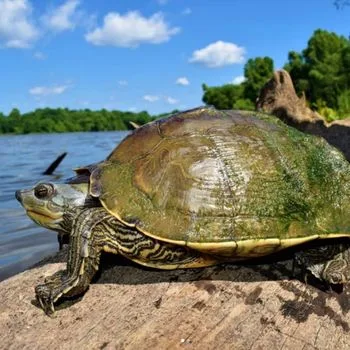 |
| 17 | Striped Mud Turtle (Kinosternon Baurii) |
| 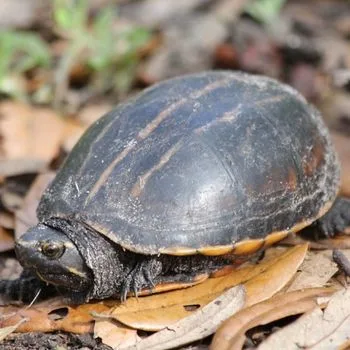 |
| 18 | Eastern Mud Turtle (Kinosternon Subrubrum) |
| 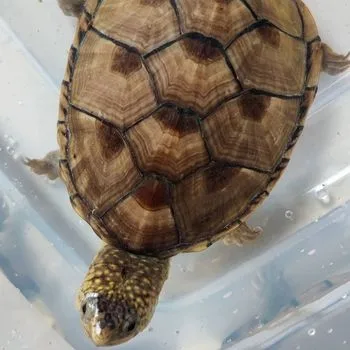 |
| 19 | Florida Mud Turtle (Kinosternon Floridanum) |
| 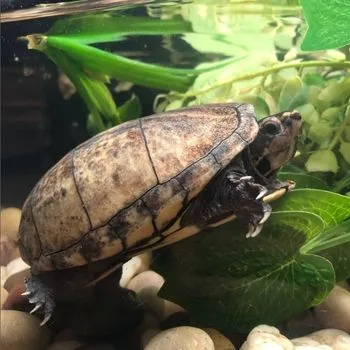 |
| 20 | Mississippi Mud Turtle (Kinosternon Subrubrum) |
| 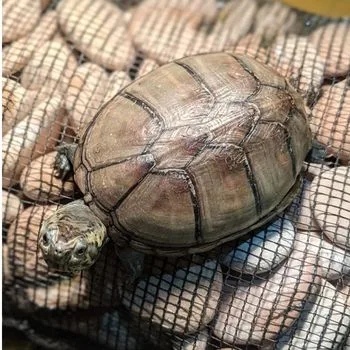 |
| 21 | Mississippi Diamondback Terrapin (Malaclemys Terrapin pileata) |
| 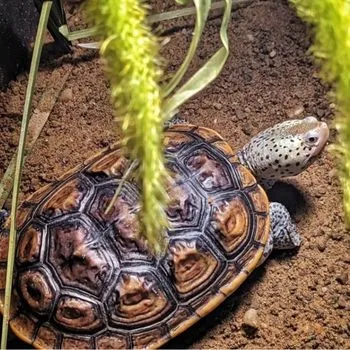 |
| 22 | Eastern River Cooter (Pseudemys Concinna) |
| 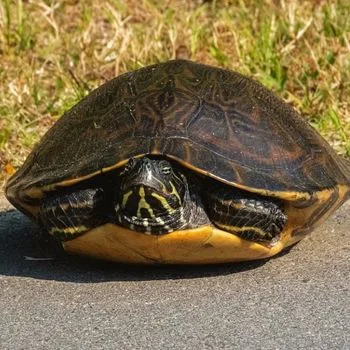 |
| 23 | Florida Cooter (Pseudemys Floridana) |
| 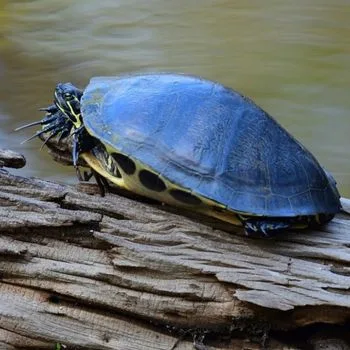 |
| 24 | Florida Red-Bellied Cooter (Pseudemys Nelsoni) |
| 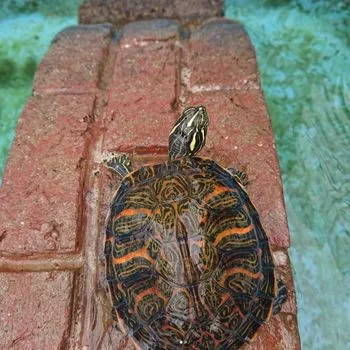 |
| 25 | Loggerhead Musk Turtle (Sternotherus Minor) |
| 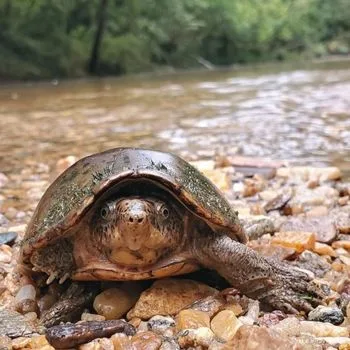 |
| 26 | Stripe-necked Musk Turtle (Sternotherus Minor peltifer) |
| 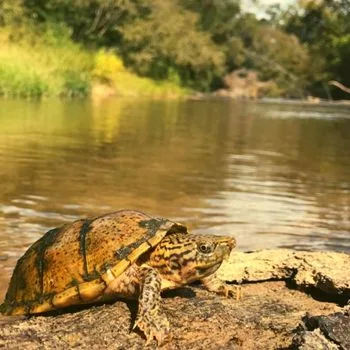 |
| 27 | Common Musk Turtle (Sternotherus Odoratus) |
| 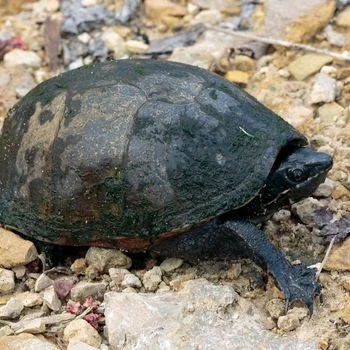 |
| 28 | Gulf Coast Box Turtle (Terrapene Carolina Major) |
| 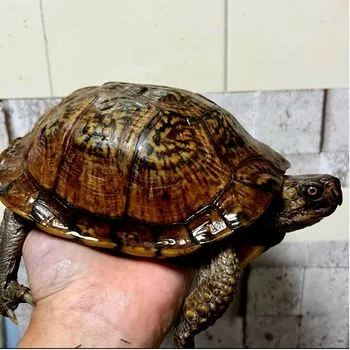 |
| 29 | Three-toed Box Turtle (Terrapene Carolina Triunguis) |
| 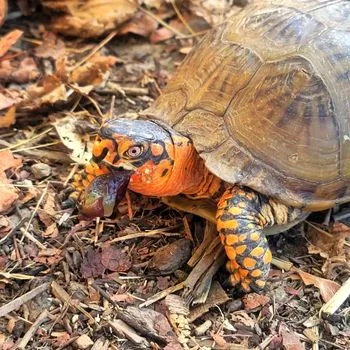 |
| 30 | Eastern Box Turtle (Terrapene Carolina) |
| 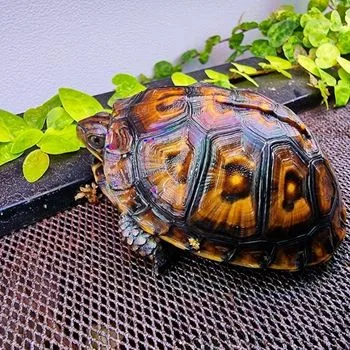 |
| 31 | Florida Box Turtle (Terrapene Carolina Bauri) |
| 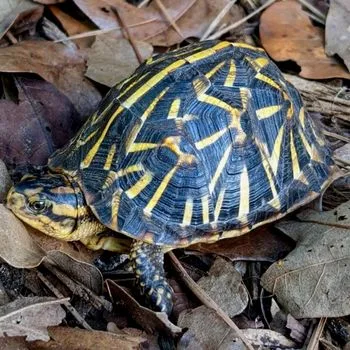 |
| 32 | Cumberland Slider (Trachemys Scripta Troostii) |
| 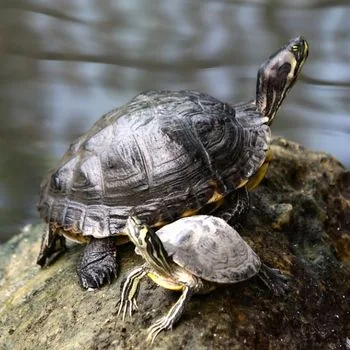 |
| 33 | Yellow-bellied Slider (Trachemys Scripta Scripta) |
| 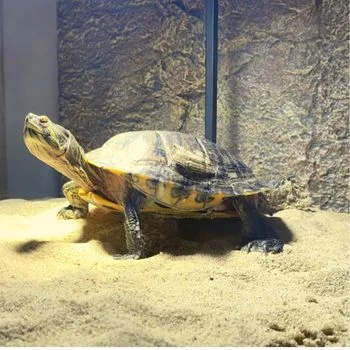 |
| 34 | Red Eared Slider (Trachemys Scripta Elegans) |
| 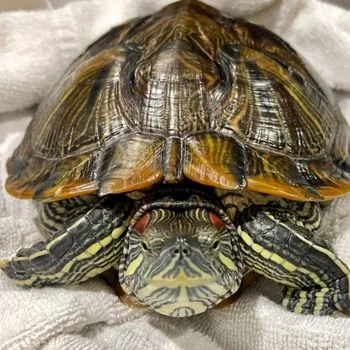 |
| 35 | Gopher Tortoise (Gopherus Polyphemus) |
| 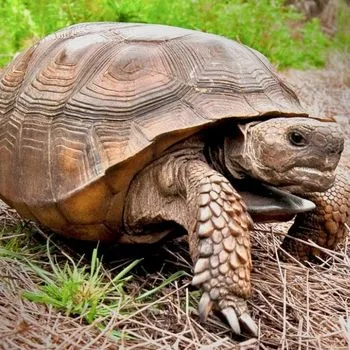 |
| 36 | Loggerhead Sea Turtle (Caretta Caretta) |
| 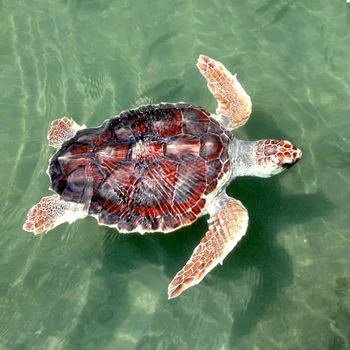 |
| 37 | Hawksbill Sea Turtle (Eretmochelys Imbricata) |
| 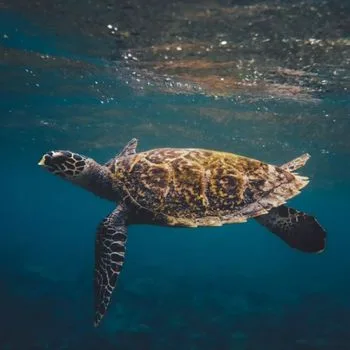 |
| 38 | Kemp’s Ridley Sea Turtle (Lepidochelys kempii) |
| 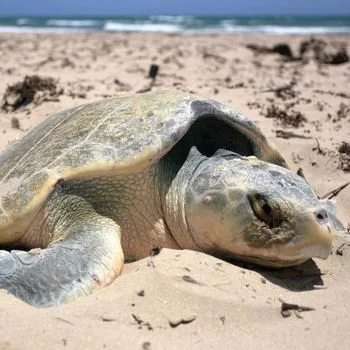 |
| 39 | Green Sea Turtle (Chelonia Mydas) |
| 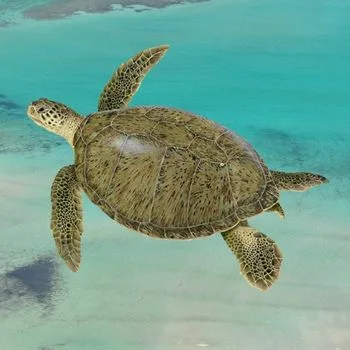 |
| 40 | Leatherback Sea Turtle (Dermochelys Coriacea) |
|  |
40 Turtles You Can Find in Georgia
In total, there are 40 species of turtles in the state of Georgia. This guide will take you on an exploration through each turtle type and provide tips for providing them with proper care. So, let’s get started on our journey into discovering all the wonders that these reptiles have to offer!
1. Bog Turtle
- Family: Emydidae
- Genus: Glyptemys
- Type: Terrestrial turtle
- Natural Habitat: Wetlands, bogs, and swamps
- Lifespan: 20-30 years
- Maximum Size: 4-5 inches
- Maximum Weight: 1-2 pounds
- Prone to Diseases: Parasites and fungal infections
- Aggression Level: Mildly aggressive, may bite if threatened
- Predators: Skunks, raccoons, and foxes
- Domestication: Illegal to possess without permit in most states
The Bog Turtle, or Glyptemys muhlenbergii, is a critically endangered species of turtle native to wetlands, bogs, and swamps in the Northeastern and north-central United States. With a carapace length of 4-5 inches and weighing around 1-2 pounds, there is no size variation between male and female Bog Turtles. They have a lifespan of 20-30 years.
Skunks, raccoons, foxes and humans are the main predators of these turtles as juveniles are highly vulnerable due to their small size. Unfortunately, they also face threats from exploitation for the pet trade—it is illegal to remove them from the wild and possess them without a permit in most states. Bog Turtles are not commonly kept as pets as they require special environments to thrive in captivity. In addition, these turtles tend to be mildly aggressive and may bite if threatened.
Bog Turtles are not well adapted to aquatic life; instead they prefer warm humid climates like those found in Georgia. As such they face massive habitat destruction due to urbanization which has led to their listing as an Endangered Species by the Endangered Species Act in several states including New York, Pennsylvania, and Vermont.
To help protect this species it is important for conservation efforts to continue in Georgia so that healthy ecosystems can be maintained throughout its range. Moreover, educational initiatives need to be established that inform people about the importance of protecting Bog Turtles before their population further declines due to the illegal collection for the pet trade and habitat loss.
2. Florida Softshell Turtle (Apalone Ferox)
- Family: Trionychidae
- Genus: Apalone
- Type: Freshwater turtle
- Natural Habitat: Freshwater rivers, streams, and ponds
- Lifespan: 20-30 years
- Maximum Size: 20-24 inches
- Maximum Weight: 30 pounds
- Prone to Diseases: Shell rot and other infections
- Aggression Level: Can be aggressive if threatened
- Predators: Adult alligators, otters, and large birds of prey
- Domestication: Can be kept as pets
Found in freshwater rivers, streams and ponds across Georgia, this species has an impressive lifespan of 20-30 years. The adults can grow up to 20-24 inches long and weigh up to 30 pounds, with males and females having little size variation.
Often mistaken as aggressive due to their formidable bite force; they will only become aggressive if disturbed or threatened by larger predators such as adult alligators and large birds of prey.
Floridian Softshell Turtles are excellent swimmers thanks to their streamlined carapace combined with webbed feet; yet sadly have now been categorized as vulnerable due to human interference through habitat destruction and exploitation.
But there’s still hope for these remarkable creatures! So let’s commit today towards conserving their natural habitats so that our future generations can also enjoy them for many more years to come!
3. Eastern Spiny Softshell Turtle (Apalone Spinifera)
- Family: Trionychidae
- Genus: Apalone
- Type: Freshwater turtle
- Natural Habitat: Slow-moving rivers, streams, ponds, and lakes with soft bottoms and abundant aquatic vegetation
- Lifespan: 30 to 40 years
- Maximum Size: 18 inches
- Maximum Weight: 12 lbs
- Prone to Diseases: Respiratory infections, shell rot, and pneumonia
- Aggression Level: Not aggressive, but will bite if threatened
- Predators: Raccoons, alligators, snapping turtles, otters, and larger fish
- Domestication: Not commonly kept as pets
The Eastern Spiny Softshell Turtle (Apalone Spinifera) is an incredible species of freshwater turtle found throughout Georgia. With powerful legs for swimming and a streamlined shell, this impressive creature has adapted to its aquatic environment over millennia. Adults measure between 8-18 inches with males being smaller at 8-12 inches compared to10-18 inches for females, weighing from 4-12lbs respectively. Despite their small size they are surprisingly strong and have a bite force that can put unsuspecting predators on their guard!
Yet these turtles aren’t all aggression; they’re also known to be quite timid and shy when humans appear near them, preferring the safety of rivers, streams or lakes – where plenty of vegetation exists in soft bottomed areas – as habitats. Unfortunately however some populations have declined due to habitat loss or collection for pets so it’s important we do everything in our power to protect these creatures and maintain a healthy ecosystem here in Georgia!
4. Common Snapping Turtle (Chelydra serpentina)
- Family: Chelydridae
- Genus: Chelydra
- Type: Freshwater turtle
- Natural Habitat: Freshwater habitats such as lakes, rivers, and swamps
- Lifespan: 50 years
- Maximum Size: 19 inches
- Maximum Weight: 40 pounds
- Prone to Diseases: Fungal infections and shell rot
- Aggression Level: Not aggressive until provoked
- Predators: River otters, bears and coyotes
- Domestication: Not recommended as pets
The Common Snapping Turtle, scientifically known as Chelydra serpentina, is an aquatic species native to freshwater habitats such as lakes, rivers and swamps. These turtles are highly adaptable and can live up to 50 years in the wild.
Adult Common Snapping Turtles typically measure 10-16 inches in shell length but can grow up to 19 inches and weigh around 40 pounds. They have a powerful bite with an estimated pressure of over 600 psi, making them one of the strongest biters among reptiles. Despite their strength they are generally not aggressive animals, though it is best to not provoke them and take caution around them.
Common Snapping Turtles often face threats from predators such as river otters, bears and coyotes when living out in the wild.
Unfortunately, their habitat is also threatened by human activities such as development and pollution which can lead to a decrease in population numbers if conservation efforts are not taken soon here in Georgia.
Although they make fascinating pets due to their long lifespan of up to 50 years when cared for properly, some states have regulations or restrictions on owning them so check with local authorities before acquiring this species as a pet.
These turtles have webbed feet for swimming and a long tail for propulsion allowing them to move quickly through water which also makes them difficult prey for predators.
Furthermore, although they occupy multiple states across North America from Alabama to Wyoming there is no other name than the Common Snapping Turtle so it’s easy to identify.
It should be noted that this species does not carry any significant disease that can be transmitted to humans yet they may still be prone to diseases like fungal infections or shell rot when kept in unsanitary conditions so proper care must be taken here in Georgia when considering owning one of these remarkable creatures as a pet.
5. Alligator Snapping Turtle (Macrochelys Temminckii)
- Family: Chelydridae
- Genus: Macrochelys
- Type: Freshwater turtle
- Natural Habitat: Slow-moving rivers, canals, lakes, and swamps in the southeastern united states
- Lifespan: 60-70 years
- Maximum Size: 30 inches
- Maximum Weight: 220 pounds
- Aggression Level: Moderate
- Predators: Large fish, birds of prey, and humans
- Domestication: Not recommended as pet
The Alligator Snapping Turtle (Macrochelys temminckii) is a large freshwater turtle native to the southeastern United States. Adults can reach up to 30 inches in length and weigh up to 220 pounds. Juvenile alligator snapping turtles are much smaller, usually between 4-10 inches in length. When you’ll come across this species in Georgia, you’ll notice that it has a very unique appearance, with an oversized head and a spiked tail that looks like an alligator’s claw.
The shell of this turtle is dark brown or black with yellow spots and stripes over it, giving the impression of scales on an alligator’s back.
Alligator snapping turtles are powerful predators and their bite force is strong enough to break through bone. They feed mainly on fish but also consume invertebrates, amphibians, and other turtles. These turtles are ambush predators, waiting for prey to come close before attacking. They are not considered aggressive towards humans but should still be handled with caution as they may bite if startled.
In the wild, alligator snapping turtles can live up to 60-70 years and have few natural predators due to their large size. However, their populations have declined in some areas due to habitat loss, illegal harvesting, and pollution. In order to protect this species from further decline, many states regulate or ban the possession of alligator snapping turtles as pets. Furthermore, it is important that you research the specific laws and regulations of your state or municipality before owning a pet turtle.
6. Eastern Painted Turtle (Chrysemys Picta)
- Family: Emydidae
- Genus: Chrysemys
- Type: Freshwater turtle
- Natural Habitat: Ponds, streams, lakes, and other aquatic habitats in eastern north america
- Lifespan: 40 years
- Maximum Size: 7-10 inches
- Maximum Weight: 21 ounces
- Prone to Diseases: Respiratory infections, shell rot, and other diseases
- Aggression Level: Not aggressive towards humans
- Predators: Foxes, raccoons, skunks, otters, and birds of prey
- Domestication: Can be kept as pets
The Eastern Painted Turtle (Chrysemys picta) is one of the most beautiful freshwater turtles found in the eastern United States, including states such as Illinois, Indiana, Ohio, Pennsylvania, New York, New Jersey, Connecticut, Rhode Island, Massachusetts, New Hampshire, Vermont, Maine, Delaware, Maryland and Virginia. With their brightly coloured shells and striking markings adorning their bodies this species is certainly a sight to behold.
The Eastern Painted Turtle can reach a length of 7-10 inches with males usually smaller than females. They have a streamlined body and webbed feet which allow them to move through the water with ease making them perfectly adapted for life in aquatic habitats like ponds, streams and lakes. In the wild they can live up to 40 years but with proper care and diet they can live up to 20-30 years in captivity; making them an ideal pet option if you’re looking for a long term companion in Georgia.
These unique little creatures are definitely worth protecting here in Georgia so by taking steps towards preserving their natural habitats we can help ensure that these vibrant animals remain part of our environment for many years to come!
7. Western Painted Turtle
- Family: Emydidae
- Genus: Chrysemys
- Type: Aquatic turtle
- Natural Habitat: Likes bodies of water with soft mud floors and abundant aquatic plants, e.g. rivers, lakes, wetlands, oxbows, ponds, ditches, and reservoirs.
- Lifespan: Usually 20 – 30 years, but in better habitat can live up to 50 years
- Maximum Size: 4 – 6 inches
- Maximum Weight: Gets about 1 pound
- Prone to Diseases: Vitamin deficiencies, metabolic bone disease, and intestinal parasites
- Disease Carrier: Salmonella
- Aggression Level: Aggressive baskers
- Predators: Raccoons, skunks, foxes, herons, other birds, snakes, and large predaceous fish
- Domestication: Can be kept as pets
The Western Painted Turtle, scientifically known as Chrysemys picta bellii, is an aquatic creature native to North America. It can be found in states such as Georgia; making its way up right into British Columbia in Canada. Adults typically measure between 9-10 inches in length while juveniles/hatchlings are smaller at around 2-3 inches.
They live in freshwater habitats such as ponds, rivers and lakes where they swim with ease due to their long tails and streamlined shells of webbed feet. Although usually not aggressive creatures, they have predators that include raccoons and herons among others which make them a species of special concern in some regions.
In most US states it is legal to keep Western Painted Turtles as pets with proper care but one should always check local regulations for necessary requirements first.
8. Southern Painted Turtle (Chrysemys picta)
- Family: Emydidae
- Genus: Chrysemys
- Type: Aquatic turtle
- Natural Habitat: Likes bodies of water with soft mud floors and abundant aquatic plants, e.g. rivers, lakes, wetlands, oxbows, ponds, ditches, and reservoirs.
- Lifespan: Usually 20 – 30 years, but in better habitat can live up to 50 years
- Maximum Size: 4 – 6 inches
- Maximum Weight: Gets about 1 pound
- Prone to Diseases: Vitamin deficiencies, metabolic bone disease, and intestinal parasites
- Disease Carrier: Salmonella
- Aggression Level: Aggressive baskers
- Predators: Raccoons, skunks, foxes, herons, other birds, snakes, and large predaceous fish
- Domestication: Can be kept as pets
The Southern Painted Turtle (Chrysemys Picta) is one of the most recognizably patterned freshwater turtles native to Georgia. These aquatic reptiles can be found in wetland habitats such as ponds, streams and slow-moving rivers. Adults typically reach a length between 4.5 to 10 inches – with females being larger than their male counterparts while they also maintain an impressive lifespan of up to 30 years!
These turtles have webbed feet, streamlined shells and retractable heads that provide them with excellent adaptations for swimming along with protection from predators. Among such predators are crows, raccoons, skunks, herons – and even larger fish that pose a threat if populations become too large.
Although these animals are not considered endangered species overall, some populations may be declining due to habitat loss or exploitation so it’s important for us all to do our part in preserving them where possible. As for those considering keeping them as pets? Please check local regulations first before taking any turtle home!
9. Midland Painted Turtle (Chrysemys Picta Marginata)
- Family: Emydidae
- Genus: Chrysemys
- Type: Aquatic turtle
- Natural Habitat: Marshes, ponds, and slow-moving streams
- Lifespan: 20 years
- Maximum Size: 4-9 inches
- Maximum Weight: Males: 1-2 pounds, females: 2-4 pounds
- Prone to Diseases: Shell rot, respiratory infections, and some other diseases
- Aggression Level: Low
- Predators: Birds of prey, raccoons, and larger turtles
- Domestication: Can be kept as pets
In the state of Georgia, you will notice this majestic species called the Midland Painted Turtle. This one is a terrestrial and aquatic turtle native to the eastern and central United States, including states such as Ohio, Illinois, and Missouri. Growing up to 9 inches for females and 4 inches for males, these turtles weigh between 1-4 pounds depending on their gender. They have webbed feet that enable them to swim with ease through the water and sharp claws used to grab their prey such as insects, snails or smaller fish. The Midland Painted Turtle can hold its breath underwater for up to 45 minutes!
In terms of behavior, these turtles are quite peaceful creatures with a low aggression level; thus making them great pet choices. However it is important to take into account their unique requirements such as providing a balanced diet, clean environment, appropriate temperature and humidity levels etc. If well taken care of they could live up to 20 years in captivity. Additionally they may be vulnerable to predation from birds of prey or racoons while common diseases include respiratory infections, shell rot or parasites due to living in unsanitary conditions.
Respectful caution should also be taken when spotting a Midland Painted Turtle since although rarely aggressive towards humans – they are still considered vulnerable according to IUCN standards and hence should not be disturbed needlessly even if encountered in nature during your visit at Georgia.
10. Spotted Turtle (Clemmys Guttata)
- Family: Emydinae rafinesque
- Genus: Clemmys
- Type: Semi-aquatic turtle
- Natural Habitat: Marshy meadows, ponds, ditches, bogs, swamps, etc. as small bodies of still water.
- Lifespan: 60 – 100+ years
- Maximum Size: 4 – 5 inches
- Maximum Weight: 0.5 to 1 pound
- Prone to Diseases: Vitamin a deficiency, respiratory diseases, abscesses, shell infections and fractures, and parasites
- Disease Carrier: Salmonella
- Aggression Level: Coexisting is possible for spotted turtles, but housing male individuals together may lead to aggression.
- Predators: Mammals, such as raccoons, muskrats, birds and large fishes.
- Domestication: Can be kept as pets
Introducing the Spotted Turtle (Clemmys Guttata)! This small, terrestrial and aquatic turtle is native to the eastern United States from Maine down to Georgia. Adults grow up to 4-5 inches in carapace length, with a weight ranging between half a pound and one pound. Juveniles can measure between 1-3 inches when they hatch.
These animals are quite hardy creatures who generally live peaceably amongst their own kind; however, under threat they may become somewhat aggressive. There are several predators that hunt them such as raccoons, skunks, snakes and birds of prey in this area.
Despite being only mildly domesticated creatures it is possible for these turtles to be kept as pets with specialized care. Prone illnesses include respiratory infections and shell rot – but fortunately this species does not act as a disease carrier itself!
11. Eastern Chicken Turtle (Deirochelys Reticularia)
- Family: Emydidae
- Genus: Deirochelys
- Type: Freshwater turtle
- Natural Habitat: Wetlands, swamps, and rivers in the southeastern united states
- Lifespan: 30 years
- Maximum Size: 8 inches
- Maximum Weight: 2 pounds
- Prone to Diseases: Respiratory infections, shell rot, and other infections
- Aggression Level: Not aggressive
- Predators: Snakes, birds, and mammals
- Domestication: Can be kept as a pet
The Eastern Chicken Turtle (Deirochelys Reticularia) is a freshwater turtle species found in wetlands, swamps and rivers of the southeastern United States. It can reach up to 8 inches (20 cm) in length and live for up to 30 years. The Eastern Chicken Turtle has no size variations between birth, juvenile, adult, male and female individuals, nor does it have any other name than its own. This shy creature is not known for being aggressive towards humans but needs to watch out from potential predators such as snakes, birds, mammals or even us humans.
This species of turtle can be kept as pets but considering some states might make it illegal to collect wild turtles or sell them as pets without proper permits—including Georgia—it is important people check with local wildlife regulations before doing so.
In captivity they may be prone to respiratory infections, shell rot or other infections common to captive specimens; however they are well-adapted aquatic habitats that might help prevent those issues from occurring if kept adequately hydrated.
Even though they are not necessarily endangered yet we should still strive to preserve their natural habitats by taking steps that improve public awareness of the challenges this species faces while living in Georgia.
12. Florida Chicken Turtle (Deirochelys Reticularia Chrysea)
- Family: Emydidae
- Genus: Deirochelys
- Type: Semi-aquatic turtle
- Natural Habitat: Wetlands, marshes, ponds, and slow-moving streams in the southeastern united states
- Lifespan: 20-25 years
- Maximum Size: 4-10 inches
- Prone to Diseases: Respiratory infections and shell rot
- Aggression Level: Not aggressive
- Predators: Raccoons, snakes, and birds of prey
- Domestication: Can be kept as a pet
The Florida Chicken Turtle is an amazing species of turtle found in the wetlands, marshes, ponds and slow-moving streams of the southeastern United States. This fascinating creature of Georgia typically measures between 4-10 inches in length with males and females being similar sized.
The Florida Chicken Turtle is a semi-aquatic creature that needs both land and water to survive. They are not aggressive by nature, but they do have predators such as raccoons, snakes and birds of prey to watch out for. These turtles can make great pets if their enclosures are kept clean and dry – otherwise they may suffer from respiratory infections or shell rot.
The average life span in captivity is 20-25 years which makes them quite resilient creatures! Though it’s not listed as endangered yet, this species can be easily found across Georgia.
13. Western Chicken Turtle (Deirochelys Reticularia Miaria)
- Family: Emydidae
- Genus: Deirochelys
- Type: Semi-aquatic turtle
- Natural Habitat: Lakes, swamps, ponds and streams characterized by slow pace and shallow depth.
- Lifespan: 15 – 25 years
- Maximum Size: Up to 10 inches
- Maximum Weight: 0.5 – 4 pounds
- Prone to Diseases: Respiratory diseases, metabolic bone issues
- Disease Carrier: Salmonella
- Aggression Level: Hostile behavior between males can be particularly noticeable.
- Predators: Raccoons, otters, ospreys, weasels, large fish and coyotes
- Domestication: Can be kept as pet if collected from a legal collector
Welcome to the remarkable world of the Western Chicken Turtle – a semi-aquatic species found across Georgia. These captivating creatures typically measure up to 10 inches in length and can weigh up to 4 pounds, making them one of the smallest turtles you may find.
Their shells have a distinctive patterned design featuring bright yellow and brown markings over an orange background, with unusually attractive wattle necks for heads! They’re also well-adapted for life in watery habitats such as ponds, lakes, swamps and streams; able to firmly grip slippery surfaces with webbed feet and even hold their breath for long periods of time!
Western Chicken Turtles make great pets if collected from legal collectors however they are quite hostile between males so please keep this in mind before taking one home. Be sure to look out for its predators too – raccoons, otters, ospreys and coyotes love these perfect little packages! Thankfully Western Chicken Turtles aren’t listed as endangered yet but it’s important that we take every opportunity we can to protect them.
14. Barbours Map Turtle (Graptemys Barbouri)
- Family: Emydidae
- Genus: Graptemys
- Type: Freshwater turtle
- Natural Habitat: Rivers and streams in the southeastern united states, primarily in alabama, mississippi, and louisiana
- Lifespan: 20-30 years
- Maximum Size: Females 8-11 inches in carapace length; males reach 5-7 inches
- Prone to Diseases: Respiratory infections and other illnesses
- Aggression Level: Not naturally aggressive, can become defensive if provoked
- Predators: Juveniles – birds, fish, and other turtles
- Domestication: Can be kept as a pet
Native to rivers and streams in the southeastern United States, primarily in Alabama, Mississippi, and Louisiana, the Barbours Map Turtle (Graptemys Barbouri) is a freshwater turtle. Upon finding one in Georgia, you will become a fan of its attractive pattern of yellow-olive streaks and spots on its carapace and legs.
Adults reach 8-11 inches in length for females and 5-7 inches for males, with males being smaller than females. Although not naturally aggressive, these turtles can become defensive if provoked. Juvenile map turtles are preyed upon by birds, fish, and other turtles. It is possible to keep them as pets but requires proper care and a large habitat since they are well-adapted to life in the water with a streamlined carapace and webbed feet.
As of now, these turtles are not at risk of endangerment but they can be prone to respiratory infections or other illnesses if conditions are not kept up properly.
15. Common Map Turtle (Graptemys Geographica)
- Family: Emydidae
- Genus: Graptemys
- Type: Aquatic turtle
- Natural Habitat: Freshwater rivers, streams, and ponds in the eastern united states
- Lifespan: 20 years
- Also Known As: Map turtle, northern map turtle
- Maximum Size: 8-10 inches
- Maximum Weight: 1-2 pounds
- Prone to Diseases: Respiratory infections and shell rot
- Aggression Level: Not aggressive
- Predators: Otters, raccoons, birds of prey, and large fish
- Domestication: Can be kept as pets
Deep in the freshwater rivers, streams and ponds of the eastern United States lies a remarkable species of turtle – the Common Map Turtle (Graptemys geographica). This species is part of the Emydidae family, and is well-adapted to aquatic life, boasting powerful webbed feet, a long neck and flat shell for swimming. Adults can grow up to 8-10 inches in length with little size variation between males and females, ranging from 1 to 2 pounds in weight.
The Common Map Turtle is often confused with other members of its genus; however, it can be easily identified by its unique pattern of yellow lines that resemble a map on its shell. Its lifespan can reach up to 20 years when kept in proper conditions. It’s important to note that this species is illegal to own as a pet in some states due to varying regulations; therefore it’s essential to check your local state laws before attempting ownership.
These turtles may not be aggressive by nature but they may bite if threatened or disturbed. They are also prone to diseases such as respiratory infections and shell rot if kept in unsanitary conditions – so it’s important to take special care when handling them if you decide to keep them as pets.
As far as predators go, otters, raccoons, birds of prey and large fish all pose a threat despite their adaptations for aquatic life. Thankfully, there are no signs that this magnificent species is currently endangered here in Georgia.
16. Alabama Map Turtle (Graptemys Pulchra)
- Family: Emydidae
- Genus: Graptemys
- Type: Aquatic turtle
- Natural Habitat: Slow-moving rivers, streams, and backwaters of the mobile river basin in alabama and neighboring states
- Lifespan: Up to 20 years
- Maximum Size: Males: 4-6 inches (10-15 cm), females: 7-10 inches (18-25 cm)
- Maximum Weight: Males: 1-2 lbs (450-900 g), females: 2-4 lbs (900-1800 g)
- Prone to Diseases: Can develop respiratory infections in captive environments with poor air quality
- Disease Carrier: Potentially carries salmonella
- Aggression Level: Not aggressive towards humans
- Predators: Birds of prey, raccoons, and large fish
- Domestication: Can be kept as pets
The Alabama Map Turtle (Graptemys pulchra) is an impressive creature found in the slow-moving rivers, streams, and backwaters of the Mobile River Basin in Alabama and neighboring states.
Growing up to 20 years old, males measure 4-6 inches while females can reach 7-10 inches — both with a weight reaching 1-4 lbs.
While not considered aggressive towards humans, it must beware of predators like birds of prey, raccoons, and large fish. It does have some drawbacks though – potentially carrying Salmonella and being prone to respiratory infections if not kept correctly.
Despite these issues these turtles in Georgia are often kept as pets legally across most states; however, their populations may be declining in Georgia due to habitat loss or people collecting them for such purposes. With its well-adapted aquatic capabilities, one can only hope that such an incredible species can continue to survive its environment safely despite ever-changing world around Q4it.
17. Striped Mud Turtle (Kinosternon Baurii)
- Family: Kinosternidae
- Genus: Kinosternon
- Type: Semi-aquatic turtle
- Natural Habitat: Slow-moving streams, swamps, and ponds
- Lifespan: 20-25 years
- Maximum Size: 4-5 inches
- Maximum Weight: 1-2 pounds
- Prone to Diseases: Shell rot, respiratory infections, and parasitic infections
- Aggression Level: Not typically aggressive, not known to bite humans
- Predators: Larger turtles, birds, and mammals
- Domestication: Not typically kept as pets
The Striped Mud Turtle (Kinosternon baurii) is a species of semi-aquatic turtle found in the state of Georgia. It is most commonly found in slow-moving streams, swamps, and ponds of Virginia, Florida, Texas, and some neighboring states.
It is a small species with an average length of 4-5 inches and weighing between 1-2 pounds. They have an impressive lifespan of up to 20-25 years in the wild which allows them to grow larger than their juvenile counterparts.
This turtle species has webbed feet which helps them swim efficiently in water while they are also adept at escaping terrestrial predators such as birds and mammals. Although Striped Mud Turtles can make great pets, it is important to check the laws in Georgia before keeping one as a pet since it may be illegal.
These turtles can suffer from health problems like shell rot and parasitic infections but are not known to transmit any diseases to humans. Despite being listed as a species of special concern in some areas, they are not considered endangered overall.
18. Eastern Mud Turtle (Kinosternon Subrubrum)
- Family: Kinosternidae
- Genus: Kinosternon
- Type: Mud turtle
- Natural Habitat: Freshwater wetlands, swamps, and slow-moving streams
- Lifespan: 30 years
- Maximum Size: 5 inches
- Maximum Weight: 9.27 ounces
- Aggression Level: Low
- Predators: Raccoons, snakes, and birds of prey
- Domestication: Not suitable as a pet
The Eastern Mud Turtle (Kinosternon subrubrum) is a small freshwater turtle found in the southeastern United States, including Georgia. This species of turtle is known for its highly aquatic adaptations and webbed feet, which make it well-suited to life in slow-moving streams, swamps, and wetlands. The Eastern Mud Turtle can reach up to 5 inches in length and has a maximum weight of 9.27 ounces. It is not aggressive, but may bite if provoked—so exercise caution when near any wild turtles!
The diet of the Eastern Mud Turtle consists primarily of aquatic invertebrates such as snails, worms, and insects. They are also opportunistic scavengers, meaning they will take advantage of carrion when available. Predators of this species include raccoons, snakes, and birds of prey. The lifespan of these turtles is up to 30 years in the wild and due to their abundance across the southeastern United States are not listed as threatened or endangered.
Although they do not make suitable pets due to their size and temperament being unsuitable for captivity, taking care to observe local wildlife regulations is important when interacting with wild Eastern Mud Turtles in Georgia . Taking steps such as preserving their natural habitats helps protect this species from destruction or poaching—ensuring they remain an iconic part of our environment for many more years to come!
19. Florida Mud Turtle (Kinosternon Floridanum)
- Family: Kinosternidae
- Genus: Kinosternon
- Type: Freshwater turtle
- Natural Habitat: Freshwater marshes, rivers, and swamps in florida and the southeastern united states
- Lifespan: 20-30 years
- Maximum Size: 3-5 inches
- Prone to Diseases: Respiratory infections, shell rot, and fungal infections
- Aggression Level: Not aggressive
- Predators: Large fish, birds, and mammals
- Domestication: Can be kept as pet
The Florida Mud Turtle (Kinosternon Floridanum) is a semi-aquatic reptile native to the southeastern United States, including Georgia. These small turtles are easily distinguished by their black or dark brown shells with yellow stripes running along each segment. They grow up to 5 inches in length, with little variation between male and female sizes.
Florida Mud Turtles feed primarily on vegetation such as leaves, flowers, grasses, algae and aquatic animals like snails, clams and insects. With its webbed feet and streamlined carapace, this species is highly adapted to aquatic life and can be found in freshwater marshes, rivers and swamps across their range.
Despite not being an endangered species yet, they are still vulnerable to human interference which threatens their natural habitats in Georgia and beyond. As such it is important to keep them safe by avoiding activities which would disrupt their natural environment like water pollution or habitat destruction.
Furthermore, although they can be kept as pets if properly cared for and given suitable housing conditions, local laws should always be checked before doing so.
20. Mississippi Mud Turtle (Kinosternon Subrubrum)
- Family: Kinosternidae
- Genus: Kinosternon
- Type: Semi-aquatic turtle
- Natural Habitat: Lives close to stagnant or slow-moving water bodies such as swamps, ponds, ditches and oxbow lakes, preferring shallow, soft-bottomed areas with vegetation. seems to steer clear of fast-flowing rivers.
- Lifespan: 15 and 20+ years
- Maximum Weight: 10 to 35 pounds
- Prone to Diseases: Vitamin a deficiency, respiratory diseases, abscesses, shell infections and fractures, and parasites
- Disease Carrier: Salmonella
The Mississippi Mud Turtle that inhabits Georgia is a semi-aquatic turtle found near a variety of slow-moving water bodies such as swamps, ponds, and ditches. They can weigh anywhere between 10 to 35 pounds and live up to 20+ years in the wild if they manage to dodge any human-introduced danger.
It has an amazing defense mechanism: its strong shell allows it to protect itself from potential predators in their natural environment, while their salmonella carrier status makes handling them not recommended! While they can be kept as pets, proper care must be taken as they’re prone to some diseases like Vitamin A deficiency, respiratory diseases, abscesses and more.
With conservation efforts, future generations will get the chance to marvel over this magnificent reptile living harmoniously within nature.
21. Mississippi Diamondback Terrapin (Malaclemys Terrapin pileata)
- Family: Emydidae
- Genus: Malaclemys
- Type: Terrestrial and aquatic
- Natural Habitat: Coastal marshes and estuaries along the atlantic and gulf coasts of the united states
- Lifespan: 20-30 years
- Maximum Size: Males: 5.5 inches, females: 11 inches
- Maximum Weight: Males: 11 ounces, females: 18 ounces
- Aggression Level: Not known to be aggressive
- Predators: Raccoons, skunks, and other predators
- Domestication: Not typically kept as pets
The Mississippi Diamondback Terrapin (Malaclemys terrapin pileata) is a species of turtle native to the Atlantic and Gulf coasts of the United States, including Georgia.
These turtles are known for their distinct diamond-shaped shell pattern, with males averaging 5.5 inches in size and females reaching up to 11 inches. Weighing an average of 11 ounces for males, and 18 ounces for females, these long-lived reptiles can live up to 20-30 years in the wild.
Unlike many other terrestrial species, Mississippi Diamondback Terrapins have adapted to life in both aquatic and terrestrial habitats. They are excellent swimmers with webbed feet and can be found in salt or brackish water habitats such as coastal marshes and estuaries. Though rarely aggressive towards humans, they should still be respected if encountered in nature due to their vulnerable status according to IUCN standards.
Unfortunately, Mississippi Diamondback Terrapins are threatened due to habitat loss and collection for the pet trade. In addition, eggs and hatchlings become easy targets for predators such as skunks or raccoons.
Despite not typically being kept as pets, they require proper care if taken into captivity – from providing a balanced diet to ensuring a clean environment free from disease or infection risks such as shell rot or respiratory infections due to poor ventilation.
This majestic species can be found along the Atlantic and Gulf coasts of the United States – including North Carolina, South Carolina, Georgia, Florida, Alabama, Mississippi, Louisiana, Texas, parts of Arkansas, Tennessee, and the Carolinas – making it a beautiful sight when visiting Georgia.
22. Eastern River Cooter (Pseudemys Concinna)
- Family: Emydidae
- Genus: Pseudemys
- Type: Freshwater turtle
- Natural Habitat: Slow-moving rivers, swamps, and other aquatic environments
- Lifespan: 30 years
- Maximum Size: 11 inches
- Maximum Weight: 8 pounds
- Prone to Diseases: Respiratory infections, shell rot, and parasites
- Aggression Level: Not known to be aggressive
- Predators: Raccoons, foxes, etc.
- Domestication: Can be kept as pets
The Eastern River Cooter (Pseudemys concinna) is a beautiful freshwater turtle found in the southeastern United States, including states such as Alabama, Georgia, South Carolina, North Carolina and Florida. With its wide flat shell adorned with striking markings of yellow and red it’s certainly an impressive sight to behold.
These unique creatures typically grow up to 10-15 inches in length; males usually being smaller than females. They have strong webbed feet and streamlined shells that make them exceptionally adapted to aquatic environments like slow-moving rivers, swamps, and lakes of Georgia. In the wild they can live up to 30 years but if well looked after they can reach 20 or more years in captivity; making them attractive pet options for those looking for long term companionship.
Their natural habitats however are under threat due to human activity so by protecting their environment we can help ensure that this stunning species remain part of our ecosystem for many generations in Georgia.
23. Florida Cooter (Pseudemys Floridana)
- Family: Emydidae
- Genus: Pseudemys
- Type: Freshwater turtle
- Natural Habitat: Freshwater habitats such as ponds, swamps, lakes, and rivers in the southeastern united states
- Lifespan: 30-40 years
- Maximum Size: 18 inches
- Maximum Weight: Males: 1.5 pounds, females: 9 pounds
- Prone to Diseases: Respiratory infections and shell rot
- Aggression Level: Low
- Predators: Birds of prey, mammals, and alligators
- Domestication: Can be kept as pets
The Florida Cooter (Pseudemys Floridana) is an incredible species of freshwater turtle that inhabits ponds, swamps, lakes and rivers in the southeastern United States.
This stunning reptile can reach up to 18 inches in length and males typically weigh about 1.5 pounds whilst females can be as heavy as 9 pounds. Despite their intimidating size, these turtles are not aggressive by nature but face threats from human activities such as over-collection for the pet trade or habitat loss in Georgia.
In order to ensure thriving wild populations of this beautiful creature it’s important to observe local laws regarding possession before bringing one into your home and provide them a clean enclosure which simulates their natural conditions for optimum health.
24. Florida Red-Bellied Cooter (Pseudemys Nelsoni)
- Family: Emydidae
- Genus: Pseudemys
- Type: Freshwater turtle
- Natural Habitat: Freshwater rivers, swamps, and lakes in florida and the southeastern united states
- Lifespan: 40 years
- Maximum Size: 10-13 inches
- Maximum Weight: 12.7 pounds
- Prone to Diseases: Respiratory infections, shell rot, and fungal infections
- Aggression Level: Not aggressive
- Predators: Large fish, birds, and mammals
- Domestication: Can be kept as pet
Meet the Florida Red-Bellied Cooter (Pseudemys Nelsoni)! This striking semi-aquatic turtle can be found in freshwater rivers, swamps and lakes in Georgia as well as across the southeastern United States.
With a lifespan of up to 40 years, these turtles are easily distinguished by their black or dark brown shells decorated with yellow stripes. They usually grow between 10-13 inches in carapace length, but males and females have little size variation.
In spite of having an impressive bite force to defend against predators like large fish, birds and mammals; their diet is mainly composed of vegetation such as leaves, flowers, grasses and algae. Additionally they can also feed on aquatic animals including snails, clams and insects.
Despite not being yet categorized as endangered species; it is important that we protect natural habitats from human interference like water pollution or habitat destruction for this species to continue living safely for many more years to come!
25. Loggerhead Musk Turtle (Sternotherus Minor)
- Family: Kinosternidae
- Genus: Sternotherus
- Type: Semi-aquatic turtle
- Natural Habitat: Freshwater rivers, streams, and ponds in the southeastern united states
- Lifespan: 30 years
- Maximum Size: 3 to 4.5 inches
- Aggression Level: Not considered aggressive towards humans
- Predators: Raccoons, foxes, and other large mammals, birds of prey
- Domestication: Not recommended as a pet
The Loggerhead Musk Turtle (Sternotherus Minor) is a remarkable creature found in the freshwater environments of the southeastern United States. This little reptile that calls Georgia its home reaches an adult size of 3 to 4.5 inches and lives up to 30 years old, making it one of the longest-lived species in its family. Its semi-aquatic nature makes it well adapted to life in the water, where it prefers habitats such as rivers, streams, and ponds.
The Loggerhead Musk Turtle is known for its distinctive markings, featuring a yellowish/brown carapace with dark spots along its ridges and a light yellow plastron on its underside. It is a docile creature that tends to be shy around people, although they may become aggressive towards each other when crowded in tight spaces. This species is not a pet, but may be regulated by state and local laws; therefore it is recommended to check with local authorities before owning one as a pet.
Sadly, this species has experienced population declines due to habitat loss caused by human activities as well as predation from larger mammals such as raccoons or foxes and birds of prey. Fortunately, it has not been listed as threatened or endangered so far which gives us hope for future conservation efforts here in Georgia. We must work together now to protect this remarkable species for future generations to appreciate its beauty!
26. Stripe-necked Musk Turtle (Sternotherus Minor peltifer)
- Family: Kinosternidae
- Genus: Sternotherus
- Type: Aquatic turtle
- Natural Habitat: Creeks, springs, ponds, rivers, and wetlands
- Lifespan: 70+ years
- Maximum Size: 3 – 4 inches
- Maximum Weight: Barely gets 1 pound
- Prone to Diseases: Mollusks oxytrema simplex and pleurocera unciale
- Disease Carrier: Salmonella
- Aggression Level: The chinese stripe-necked turtle is a competitive species, dominating other turtles for resources and habitat. only one specimen has ever been discovered in the wild in australia, specifically in toowoomba in 2014.
- Predators: Large fish, raccoons, foxes, skunks, and big wading birds all fall under the category of common wildlife
- Domestication: Endangered species, can’t be kept as pets
The Stripe-necked Musk Turtle is a unique species found in freshwater environments such as slow-moving streams, ponds, swamps, and other habitats. These turtles typically range from 4 to 6 inches long and can live up to 25 years when given the right care and environment.
They have webbed feet for swimming which gives them a streamlined shape that makes it easy for them to move through the water quickly – an adaptation that proves useful against predators like raccoons or herons!
These docile creatures make great companions when kept as pets but you must check Georgia’s specific laws before doing so.
Even though not all populations of these amazing animals are endangered yet, their numbers have been declining across Georgia due to rapid habitat loss or exploitation – something we should pay close attention to if we wish to ensure this special creature has a secure future ahead!
27. Common Musk Turtle (Sternotherus Odoratus)
- Family: Kinosternidae
- Genus: Sternotherus
- Type: Terrestrial and aquatic turtle
- Natural Habitat: Streams, rivers, ponds, and swamps in eastern north america
- Lifespan: 10-20 years
- Also Known As: Stinkpot
- Maximum Size: 4-8 inches
- Maximum Weight: 0.7 pounds
- Prone to Diseases: Respiratory infections and shell rot
- Aggression Level: Agressive but not known to bite humans
- Predators: Raccoons, mink, birds of prey, and large fish
- Domestication: Can be kept as pets
The Common Musk Turtle (Sternotherus Odoratus) is a terrestrial and aquatic turtle found in streams, rivers, ponds, and swamps throughout the eastern United States. This species can reach an impressive length of 4-8 inches when fully grown, with an average weight of 0.7 pounds. Interestingly, these turtles are also known as ‘Stinkpots’ due to their ability to secrete a musky odour when alarmed or threatened.
Their flat carapace makes them well adapted for life in the water, with strong webbed feet and sharp claws helping them cling onto rocks or vegetation while searching for food. As omnivores they feed on snails, clams and other insects as well as plant matter such as algae and leaves – making them a vital part of the local ecosystem here in Georgia. They are generally non-aggressive but may bite if disturbed or threatened by predators such as river otters, raccoons, mink and birds of prey.
The Common Musk Turtle is not currently listed as an endangered species but habitat loss due to human activities such as development and pollution can lead to a decrease in population numbers – especially without proper conservation efforts. Additionally, illegal pet trade can be an issue that affects their vulnerability so it’s important to check local regulations before acquiring this species as a pet.
Despite all this however, with proper care these turtles have been known to live up to 20 years making them great companions for experienced keepers who are willing to put in the effort necessary for their special care needs here in Georgia.
28. Gulf Coast Box Turtle (Terrapene Carolina Major)
- Family: Emydidae
- Genus: Terrapene
- Type: Terrestrial/semi-aquatic turtle
- Natural Habitat: Coastal plain forests, pine flatwoods, and dune habitats along the gulf coast
- Lifespan: 50 years
- Maximum Size: 5-7 inches
- Maximum Weight: 2 pounds
- Prone to Diseases: Respiratory infections, shell rot, and parasites
- Aggression Level: Not aggressive
- Predators: Foxes, raccoons, and skunks
- Domestication: Yes, can be kept as a pet
Introducing the majestic Gulf Coast Box Turtle, one of the many incredible species native to Georgia. Growing up to 7 inches in length and weighing around 2 pounds, this terrestrial/semi-aquatic creature prefers coastal plain forests, pine flatwoods and dune habitats along the Gulf Coast.
These stunning turtles have a lifespan that can reach up to 50 years if left undisturbed by its predators like foxes, raccoons or skunks. They are particularly adapted for land living but will occasionally enter water sources such as ponds or streams in order to bask.
Sadly enough though they are listed as threatened species in Florida due to human activities which puts them at risk of extinction unless preventative steps are taken soon. Let’s strive towards preserving its population so future generations can marvel atGeorgia’s natural beauty!
29. Three-toed Box Turtle (Terrapene Carolina Triunguis)
- Family: Emydidae
- Genus: Terrapene
- Type: Semi-aquatic turtle
- Natural Habitat: Humid areas such as marshes and grassy lands
- Lifespan: 30 – 40 years
- Maximum Size: 5 – 7 inches
- Maximum Weight: Up to 2 pounds
- Prone to Diseases: Clinical mycoplasma infections, mbd
- Disease Carrier: Salmonella
- Aggression Level: Not aggressive
- Predators: Mammals, such as raccoons, muskrats, birds and large fishes.
- Domestication: Illegal to possess without permit in most states
This remarkable reptile inhabits deciduous forests, grasslands, and wetlands across parts of the eastern and central United States including Georgia.
Its average length is 4.5 to 5.5 inches while its weight averages between 0.5 to 1 pound with no size or gender differences seen in adults. Although they are mild by nature, these reptiles need proper care and maintenance if kept as pets – some states like Florida have even put restrictions on owning them as a pet!
Fortunately, their strong shells protect them from predators like snakes, raccoons, and skunks; however human activities such as habitat destruction have resulted in this species being listed as a special concern in some states due to the loss of habitats.
30. Eastern Box Turtle (Terrapene Carolina)
- Family: Emydidae
- Genus: Terrapene
- Type: Terrestrial turtle
- Natural Habitat: Deciduous and mixed forests, meadows, and fields
- Lifespan: 60 years
- Also Known As: Eastern terrapin
- Maximum Size: 4-10 inches
- Maximum Weight: Male: 1 pounds, females: 2 pounds
- Prone to Diseases: Respiratory infections, shell rot, and other diseases
- Aggression Level: Not aggressive towards humans
- Predators: Raccoons, skunks, opossums, and snakes
- Domestication: Can be kept as pets
The Eastern Box Turtle (Terrapene Carolina) is one of the most intriguing species found in deciduous and mixed forests, meadows, and fields of eastern North America. This incredible turtle can live up to 40 years in the wild or even reach up to 60 years in captivity! With adult sizes ranging from 4-10 inches, males being slightly smaller than females with a weight of 0.5-1 lb for males and 1-2 lbs for females.
Eastern Box Turtles are not too aggressive towards humans but potential predators may include raccoons, skunks, opossums, and snakes. They can be kept as pets but it is important to consult local laws before doing so since some states make it illegal to collect wild turtles or sell them as pets—including Georgia. Captive Eastern Box Turtles may be prone to respiratory infections, shell rot, and other diseases common to captive turtles.
This species is state-protected in several states due to the declining population caused by habitat loss and illegal collection for the pet trade. Despite this precarious situation, Eastern Box Turtles can still be found in eastern North America—including Georgia. It is essential that we take steps to protect this species which calls Georgia home by preserving their natural habitats as well as improving public awareness of their plight!
31. Florida Box Turtle (Terrapene Carolina Bauri)
- Family: Emydidae
- Genus: Terrapene
- Type: Terrestrial turtle
- Natural Habitat: Dense forests, scrublands, and wetlands
- Lifespan: 30-50 years
- Maximum Size: 4-8 inches
- Maximum Weight: 8 ounces
- Prone to Diseases: Respiratory infections and shell rot
- Aggression Level: Low
- Predators: Raccoons, skunks, and snakes
- Domestication: Can be kept as pets
The Florida Box Turtle (Terrapene Carolina Bauri)—a unique and fascinating species of terrapene found mostly in the state of Florida and adjacent parts of Georgia and Alabama. This turtle can be easily identified by its dome-shaped carapace with bright yellow markings, as well as its pointed snout. The adult size ranges from 4 to 8 inches long, with males typically being larger than females, averaging around 8 ounces for males and 6 ounces for females.
Despite their small size, these turtles are well adapted to life on land! They prefer densely forested areas, scrublands, and wetlands where they can burrow into the soil or hide amongst vegetation. Additionally, they possess incredibly strong jaws that allow them to feed on a wide variety of prey items such as insects, fruits, mushrooms, flowers and more!
Unfortunately due to habitat loss and over-collection for the pet trade, the Florida Box Turtle is now considered threatened in the wild. It is therefore important that we follow local laws governing pet ownership in Georgia if we wish to see generations of these fascinating turtles persist in our environment.
32. Cumberland Slider (Trachemys Scripta Troostii)
- Family: Emydidae
- Genus: Trachemys
- Type: Terrestrial and aquatic turtle
- Natural Habitat: Streams, rivers, and ponds in the cumberland plateau region of the southeastern united states
- Lifespan: 30 years
- Maximum Size: 15 inches
- Maximum Weight: 7 pounds
- Prone to Diseases: Respiratory infections, shell rot, and vitamin a deficiency
- Aggression Level: Mildly aggressive
- Predators: Raccoons, large fish, and birds of prey
- Domestication: Can be kept as a pet
With males typically reaching up to 11 inches and females up to 15 inches in length, this species is well adapted for both aquatic and terrestrial life with webbed feet for swimming and a streamlined body.
These turtles are not particularly aggressive when handled, though they can be mildly so if disturbed. Predators in the wild include raccoons, large fish, birds of prey and humans who have been known to over-harvest them for the pet trade causing threats to population numbers.
As such, it is important to check with local authorities before acquiring this species as a pet since special care must be taken due to their vulnerability to diseases like fungal infections or shell rot when kept in unsanitary conditions.
With proper care these turtles can live for up to 30 years making them great companions for experienced keepers who are willing to put in the effort necessary for their special care needs here in Georgia.
Although they are quite hardy animals able to survive a variety of conditions they should still be fed a balanced diet consisting of protein sources such as worms, insects, crayfish and even some plants as well as supplemented Vitamin A fortified food items.
Currently this species is not listed as either threatened or endangered however due to potential habitat destruction caused by human activities such as development and pollution it is important that conservation efforts are taken before it’s too late so future generations may witness this remarkable species of turtle here in Georgia.
33. Yellow-bellied Slider (Trachemys Scripta Scripta)
- Family: Emididae
- Genus: Trachemys
- Type: Freshwater turtle
- Natural Habitat: Slow-moving rivers, floodplain swamps, marshes, seasonal wetlands, and permanent ponds
- Lifespan: 20-30 year
- Maximum Size: 8 – 12 inches
- Maximum Weight: Up to 3 pounds
- Disease Carrier: Salmonella
- Aggression Level: When kept in pairs, yellow-bellied slider turtles may exhibit aggression, unlike their docile behavior when housed individually.
- Predators: Raccoons (procyon lotor) and humans, who shoot them while basking, kill them on roads, and fracture shells with boat propellers. hatchlings and juveniles are eaten by large fish, some snakes, raccoons, and wading birds
Native to the southeastern United States from Florida to Virginia, the Yellow-bellied Slider (Trachemys Scripta Scripta) is a freshwater turtle. These beautifully patterned creatures have yellow shells with black patches around each scute as well as bright yellow bellies, giving them their name. They can measure up to 12 inches long and weigh up to 3 pounds.
In Georgia, these turtles are found in low-moving rivers, floodplain swamps, marshes, seasonal wetlands and permanent ponds . In the wild they usually lead solitary lives and do not show aggression towards other animals unless kept in pairs when some competition may arise over certain mates.
Sadly raccoons (Procyon lotor) and humans are major threats for these vulnerable reptiles due to disturbance of their habitats or hunting them down for food or sport; juveniles also face even more trouble since they’s likely be eaten by large fish, some snakes, raccoons and wading birds if left unprotected! Conservation efforts need to be increased so that this majestic species will continue inhabiting our planet far into future generations!
34. Red Eared Slider (Trachemys Scripta Elegans)
- Family: Emydidae
- Genus: Trachemys
- Type: Aquatic turtle
- Natural Habitat: Streams, rivers, ponds, lakes, swamps, and marshes
- Lifespan: 20 – 30 years
- Also Known As: Red-eared terrapin
- Maximum Size: 7 – 12 inches, females get larger than 12 inches
- Maximum Weight: 3 – 6 pounds
- Prone to Diseases: Respiratory infections, shell rot, and other diseases if kept in unsanitary conditions.
- Disease Carrier: Salmonella
- Aggression Level: Not aggressive
- Predators: Raccoons, otters, fish, frogs, snakes, skunks and birds
- Domestication: Can be kept as pets
The Red Eared Slider (Trachemys scripta elegans) is a freshwater reptile with a striking appearance. Found in Georgia’s waterways, these turtles can reach up to 10-12 inches long as adults and can live for an impressive 30 years. They have webbed feet that are adapted for swimming, making them incredibly agile aquatic creatures.
Males and females exhibit different size ranges, with males being more diminutive compared to the females and juveniles measuring only 2-3 inches when fully grown. Although they may take on aggressive postures if threatened, their bite force is not enough to cause any damage to humans or other larger animals.
It’s important that we respect the habitats of these amazing reptiles so that future generations will be able to enjoy them too – keep their environments clean by disposing of garbage properly and avoid disturbing the fragile ecosystems where they make their homes!
35. Gopher Tortoise (Gopherus Polyphemus)
- Family: Testudinidae
- Genus: Gopherus
- Type: Terrestrial tortoise
- Natural Habitat: Dry, sandy soils of longleaf pine forests, scrub, coastal dunes, and rocky uplands in the southeastern united states
- Lifespan: 80 years
- Maximum Size: 15 inches
- Maximum Weight: 15 pounds
- Prone to Diseases: Respiratory infections, digestive problems, and shell infections
- Aggression Level: Low
- Predators: Raccoons, feral pigs, armadillos, fire ants, and various bird species
- Domestication: Can be kept as a pet in some states
The Gopher Tortoise (Gopherus Polyphemus) is a remarkable terrestrial species found across Georgia. With an impressive lifespan of up to 80 years in captivity, adults measure up to 15 inches in length and can weigh around 10-15 pounds. Generally these creatures are quite docile and are not prone to aggression unless provoked or threatened by larger predators such as humans, armadillos, raccoons and birds of prey.
Habitually they live in dry sandy soils such as those found in longleaf pine forests, scrub areas, coastal dunes or rocky uplands. Sadly many states now consider this creature endangered due to their habitat being destroyed through human interference; meaning any attempts to keep these residents of Georgia as a pet will often require special permits depending on where you live.
Nevertheless with the right care, these incredible animals may still be preserved for generations yet come! So let us commit ourselves towards protecting Gopher Tortoises today so that our future descendants may also have the opportunity witness their stunning beauty!
36. Loggerhead Sea Turtle (Caretta Caretta)
- Family: Cheloniidae
- Genus: Caretta
- Type: Sea turtle
- Natural Habitat: Coastal waters, bays, and estuaries
- Lifespan: 40-50 years
- Maximum Size: 3-3.5 ft
- Maximum Weight: 220-355 pounds
- Prone to Diseases: Fibropapillomatosis and debilitative shell disease
- Aggression Level: Not typically aggressive
- Predators: Juveniles – birds, crabs, and mammals; adults – large marine animals such as sharks
- Domestication: Cannot be kept as pets
The Loggerhead Sea Turtle (Caretta caretta) is a remarkable species found in the coastal waters, bays, and estuaries of the Atlantic and Pacific coasts of the United States, as well as in the Gulf of Mexico. This semi-aquatic creature that roams our state of Georgia has a unique adaptation – its carapace (top shell) is patterned like the skin of a shark, allowing it to blend perfectly with its environment. A fully grown adult can reach up to 3-3.5 ft in length and weigh up to 400 pounds, though there is virtually no size difference between males and females.
Loggerhead Sea Turtles are highly adapted to their aquatic lifestyle, with webbed feet for navigation and long claws for catching their prey such as insects, snails or fish. They can also hold their breath for extended periods of time and have a specialized streamlined body shape which helps reduce drag while swimming.
Unfortunately, due to destruction of its wetland habitats and other human activities, population declines have been reported in some areas; therefore this species is classified as vulnerable by the IUCN and protected under the Endangered Species Act. So it is important that local authorities be consulted before owning one as they cannot be kept as pets due to their specialized habitat requirements.
Living up to 40-50 years in the wild these gentle creatures rarely show aggression towards humans but should still be respected with caution since they are vulnerable to predation from marine mammals such as sharks or birds and crabs when young.
37. Hawksbill Sea Turtle (Eretmochelys Imbricata)
- Family: Cheloniidae
- Genus: Eretmochelys
- Type: Marine turtle
- Natural Habitat: Tropical and subtropical oceans, coral reefs, lagoons, and rocky coasts
- Lifespan: 30-50 years
- Maximum Size: 24-35 inches
- Maximum Weight: 88-110 pounds
- Aggression Level: Not aggressive towards humans
- Predators: Large fish and birds
- Domestication: Not suitable as a pet
The Hawksbill Sea Turtle (Eretmochelys Imbricata) is an incredible species of marine turtle, native to tropical and subtropical oceans around the world. These beautiful creatures can grow up to 35 inches in carapace length and weigh up to 110 pounds. They are known for their unique beak-like snout which has given them their distinctive name ‘Hawksbill’.
Despite being highly adapted for life underwater, with powerful flippers perfect for swimming and the ability to hold its breath for long periods of time, these turtles face numerous threats from human activities such as hunting, poaching beach destruction and pollution. As a consequence they are classified as endangered by IUCN – The International Union for Conservation of Nature – making it illegal to own one as a pet in many states and countries.
Unfortunately populations have decreased drastically over recent decades due mainly to these pressures but also increasingly due climate change related events such as rising sea levels affecting nesting sites.
We must act now if we want future generations in Georgia to be able observe this amazing species living peacefully in its natural habitat!
38. Kemp’s Ridley Sea Turtle (Lepidochelys kempii)
- Family: Cheloniidae
- Genus: Lepidochelys
- Type: Aquatic turtle
- Natural Habitat: Freshwater rivers, streams, and ponds
- Lifespan: 20-30 years
- Maximum Size: 30 inches
- Maximum Weight: 110 pounds
- Aggression Level: Not aggressive
- Predators: Raccoons, otters, and large fish
- Domestication: Can be kept as pets
The Kemp’s Ridley Sea Turtle is an aquatic reptile native to the southeastern United States, most commonly found in states such as Alabama, Georgia, and Florida. These majestic creatures that call Georgia their home have a long and impressive lifespan of up to 20-30 years with adults reaching up to 30 inches in length and 110 pounds in weight, with males being slightly smaller than females.
The Kemp’s Ridley Sea Turtle has adapted perfectly for life underwater; aquatically equipped with webbed feet and able to hold their breath for extended periods of time allowing them to outswim most danger. The webbing on its feet provides an immensely powerful swimming technique whilst their streamlined bodies provide amazing agility beneath the waves.
Their carapace is a beautiful olive green colour that blends into the environment perfectly, so they can go unnoticed when needed. This species also has no specific predators apart from raccoons, otters and large fish seeking them out as food, which makes them quite a safe species compared to other turtles living closer to shorelines.
Unfortunately they are listed as vulnerable due to their low population size; this is mainly caused by humans polluting our oceans and destroying their natural habitat. It’s important that we work together now to preserve our planet’s natural ecosystems so future generations can appreciate its beauty here in Georgia. This is especially true of this beautiful Kemp’s Ridley Sea Turtle so it may yet be enjoyed long into the future!
39. Green Sea Turtle (Chelonia Mydas)
- Family: Cheloniidae
- Genus: Chelonia
- Type: Marine turtle
- Natural Habitat: Coastal waters, bays, lagoons, and shallow seagrass beds in tropical and subtropical oceans
- Lifespan: 80 years
- Also Known As: Green turtle
- Maximum Size: 5 feet
- Maximum Weight: 400 pounds
- Aggression Level: Low
- Predators: Birds, mammals, and large fish
- Domestication: Not suitable as pets
Introducing the majestic Green Sea Turtle, an incredible species that inhabits tropical and subtropical coastal oceans in many parts of the world. These residents of Georgia can reaching up to five feet in length and weigh around 400 pounds for females.
This marine turtle can live for about 80 years if left undisturbed by humans or predators such as birds, mammals, or large fish.
With flippers adapted for swimming and a streamlined body shape allowing it to hold its breath underwater for long periods at a time, they are highly adapted to navigating in their natural aquatic habitats.
Sadly enough though these creatures are endangered worldwide due to human actions which puts them at risk of extinction unless preventative steps are taken soon. Let’s strive towards preserving its population so future generations can witness Georgia’s coastlines come alive with the beauty of these magnificent animals!
40. Leatherback Sea Turtle (Dermochelys Coriacea)
- Family: Dermochelyidae
- Genus: Dermochelys
- Type: Marine turtle
- Natural Habitat: Open ocean and near-shore habitats in warmer regions
- Lifespan: 45 years
- Maximum Size: 6.7 feet
- Maximum Weight: 2,000 pounds
- Aggression Level: Low
- Predators: Birds and other marine animals
- Domestication: Not a pet
The Leatherback Sea Turtle (Dermochelys Coriacea) is one of the most remarkable creatures you can find in the depths of ocean. This majestic creature, also known as simply Leatherback Turtle, has adapted to life at sea by having a streamlined body and flippers that give it an immense advantage for swimming long distances.
It has been known to reach up to 6.7 feet in length and its size can weigh up to 2,000 pounds; thus making this resident of Georgia one of the largest reptiles on Earth!
This species lives mainly in open ocean habitats with warmer regions such as those around the coasts of California, Florida or Mexico but sometimes ventures near-shore areas looking for food or breeding grounds.
Unfortunately due to human activities like hunting them for their valuable shells or accidental catches while fishing these animals have been classified as endangered (IUCN Red List). We must therefore work together now and take action if we want this species preserved so future generations can enjoy its beauty here in Georgia.
Final Words
In the state of Georgia—a place rich in biodiversity—turtles play a significant role; with a variety of species dwelling in its forests, beaches, and rivers.
In this article, we took a closer look at these fascinating creatures (including their natural habitats, lifespan, size and weight, predators, and domesticability). It’s worth noting that, while keeping these turtles as pets is legal; their populations in Georgia may be declining due to habitat loss and collection for the pet trade.
It is our responsibility to ensure that these turtles remain protected and preserved for future generations to enjoy in the state of Georgia.
Other Nearby States:
- Turtles In Alabama
- Turtles In Florida
- Turtles In Tennessee
- Turtles In North Carolina
- Turtles In South Carolina

